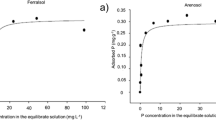Abstract
The agronomic effectiveness of two partially acidulated rock phosphate (PARP) fertilizers, made from either North Carolina or Moroccan apatite rock phosphate, and a fused calcium-magnesium phosphate (thermal phosphate or TP), was compared with the effectiveness of superphosphate in two glasshouse experiments. A different lateritic soil from Western Australia was used for each experiment. Oats (Avena sativa) were grown in one experiment and triticale (×Triticosecale) in the other. Fertilizer effectiveness was measured using (i) yield of dried tops, (ii) P content (P concentration in tissue multiplied by yield) of dried tops, and (iii) bicarbonate-extractable soil P (soil test value).
The following relationships differed for the different fertilizers: (i) yield of dried tops and P content in the dried tops; (ii) yield and soil test values. Consequently the fertilizer effectiveness values calculated using yield data differed from those calculated using P content or soil test data. Freshly-applied superphosphate was always the most effective fertilizer regardless of the method used to calculate fertilizer effectiveness values. For one of the soils, as calculated using yield data, relative to freshly-applied superphosphate, the PARP and TP fertilizers were 15 to 30% as effective for the first crop, and 20 to 50% as effective for the second crop. The second soil was more acidic, and for the first crop the PARP and TP fertilizers were 80 to 90% as effective as freshly-applied superphosphate, but all fertilizers were only 5 to 15% as effective for the second crop. For each soil, the two PARP fertilizers had similar fertilizer effectiveness values. Generally the TP fertilizer was more effective than the PARP fertilizers.
Similar content being viewed by others
References
AOAC (1975) ‘Official Methods of Analysis’ 12 edn. Assoc Of Anal Chem: Washington DC
Barrow NJ and Campbell NA (1972) Methods of measuring residual value of fertilizers. Aust J Exp Agric Anim Husb 12: 502–510
Black CA and Scott CO (1956) Fertilizer evaluation. I. Fundamental principles. Soil Sci Soc Am Proc 20: 176–179
Bolland MDA, Weatherley AJ and Gilkes RJ (1988) Residual effectiveness of superphosphate is greater than that of rock phosphate fertilizers for lateritic soils in south-western Australia. Aust J Exp Agric 28: 83–90
Bolland MDA and Gilkes RJ (1989) Reactive rock phosphate fertilizers and soil testing for phosphorus: the effect of particle size of the rock phosphate. Fert Res 21: 75–93
Bolland MDA and Gilkes RJ (1990) Rock phosphates are not effective fertilizers in Western Australian soils: a review of one hundred years of research. Fert Res 22: 79–96
Boltz DF and Lueck CH (1958) Phosphorus.In: DF Boltz (ed) Colorimetric Determination of Non-Metals. Intersc Publ: New York
Colwell JD (1963) The estimation of phosphorus fertilizer requirements of wheat in southern New South Wales by soil analysis. Aust J Exp Agric Anim Husb 3: 190–197
McLachlan KD and Norman BW (1969) A comparison of calcium-magnesium phosphate and superphosphate as phosphate fertilizers on acid soils. Aust J Exp Agric Anim Husb 9: 341–349
McLean EO and Wheeler RW (1964) Partially acidulated rock phosphates as a source of phosphorus to plants. I. Growth chamber studies. Soil Sci Soc Am Proc 28: 545–550
Mokwunye AU and Chien SH (1980) Reactions of partially acidulated phosphate rock with soils from the tropics. Soil Sci Soc Am J 44: 477–482
Northcote KH (1979) ‘A Factual Key for the Recognition of Australian Soils’. 4th edn. Rellim Tech Publ: Glenside, South Australia
Ozanne PG and Shaw TC (1967) Phosphate sorption by soils as a measure of the phosphate requirement for pasture growth. Aust J Agric Res 29: 225–233
Palmer B and Gilkes RJ (1982) Agronomic evaluation of calcined Christmas Island iron-aluminium phosphate fertilizers. Proc Phos Pot Tropic Conf, Kuala Lumpur (eds E Puspharajah and HAH Sharifuddin) pp. 495–507. Malay Soc Soil Sci: Malaysia
Rajan SSS (1985) Partial acidulation of an ‘unground’ phosphate rock. 1. Preparation and characteristics. Fert Res 8: 147–155
Russell EWC (1966) ‘Soil Conditions and Plant Growth’. Longmans, Green and Co: London
Sale PWG and Blair GJ (1989) Low solubility phosphate fertilizers for pastures: an alternative prospect. Agric Sci 2: 34–39
Sinclair AG (1975) Reaction of fused calciummagnesium phosphate and superphosphate on a highly phosphate-fixing soil. II. Placement effects. NZ J Exp Agric 3: 111–116
USDA Soil Survey Staff (1975) Soil taxonomy — a basic system of soil classification for making and interpreting soil surveys. USDA Washington DC
Walkley A and Black IA (1934) An examination of the Degtjareff method of determining soil organic matter and a proposed modification of the chromic and titration method. Soil Sci 37: 29–38
Weatherley AJ, Bolland MDA and Gilkes RJ (1988) A comparison of values for initial and residual effectiveness of rock phosphates measured in pot and field experiments. Aust J Exp Agric 28: 753–763
White RE, Hedley MJ, Bolan NS and Gregg PEH (1989) Recent developments in the use of phosphate fertilizers on New Zealand pastures. Agric Sci 23: 26–32
Author information
Authors and Affiliations
Rights and permissions
About this article
Cite this article
Bolland, M.D.A., Glencross, R.N., Gilkes, R.J. et al. Agronomic effectiveness of partially acidulated rock phosphate and fused calcium-magnesium phosphate compared with superphosphate. Fertilizer Research 32, 169–183 (1992). https://doi.org/10.1007/BF01048780
Received:
Accepted:
Issue Date:
DOI: https://doi.org/10.1007/BF01048780




